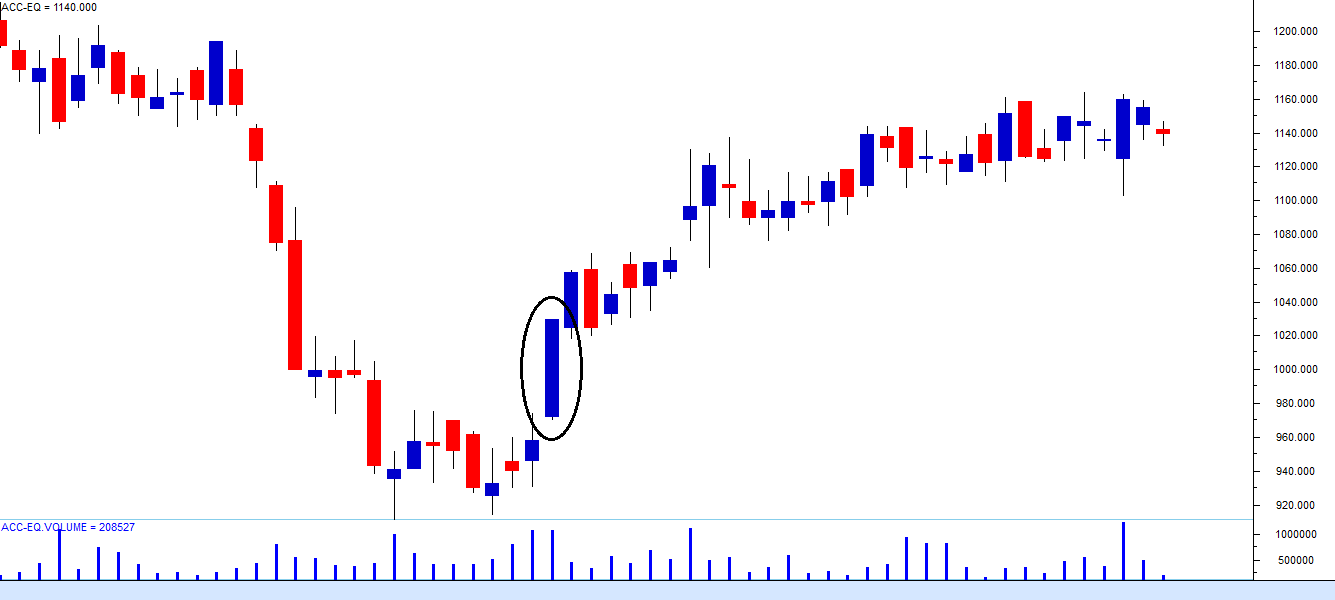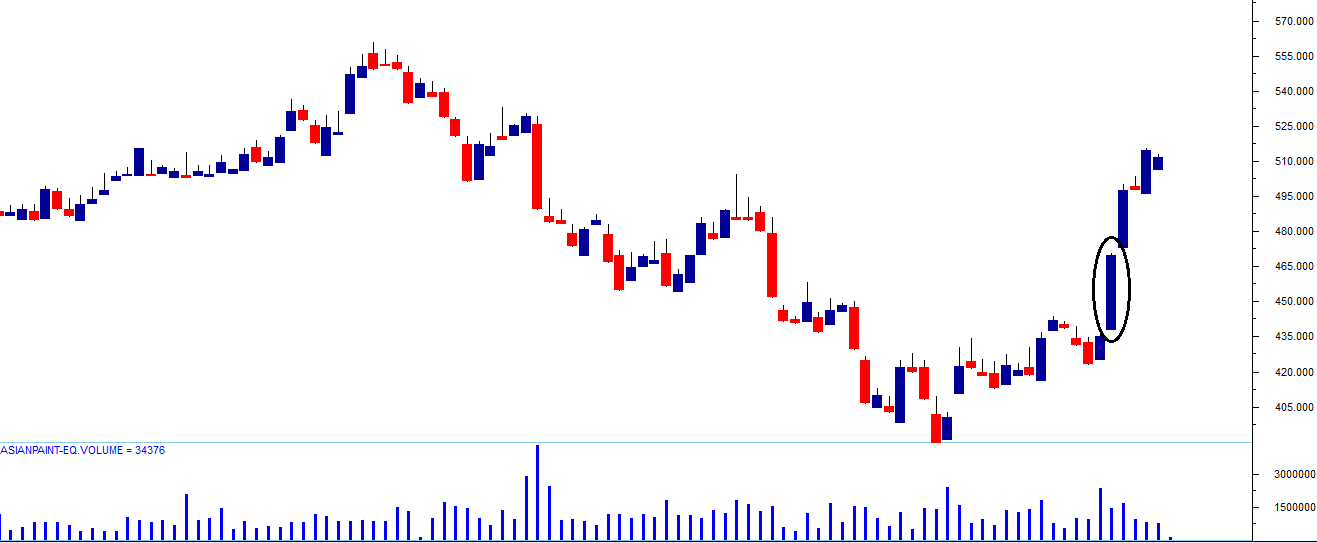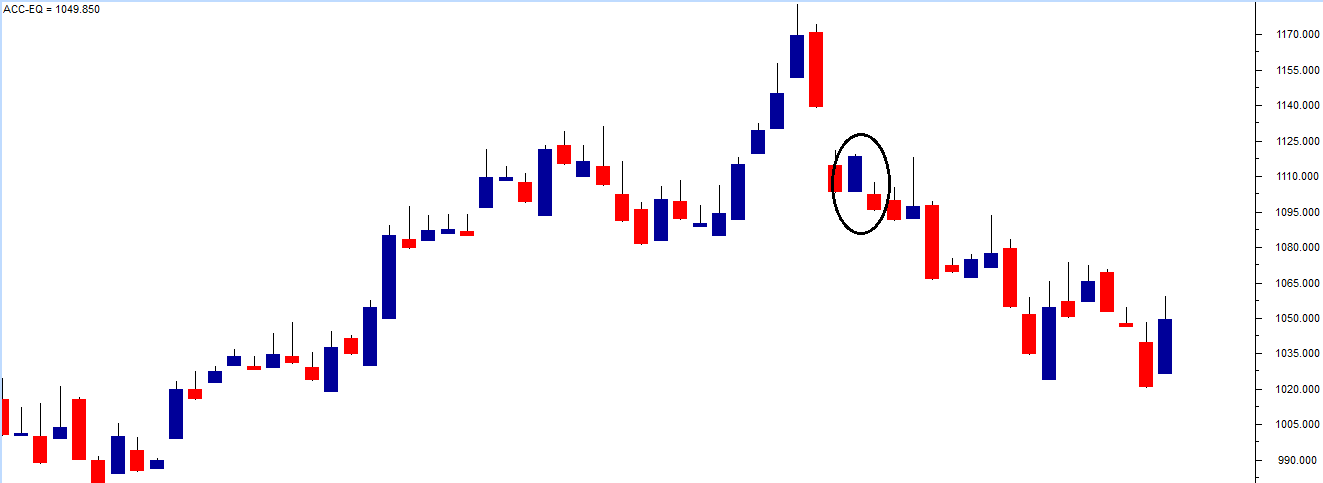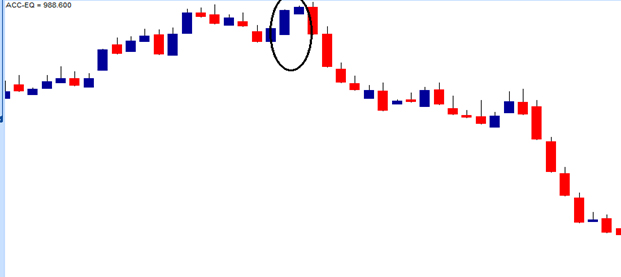The Marubozu is the first single candlestick pattern that we will understand. The word Marubozu means “Bald” in Japanese. We will understand the context of the terminology soon. There are two types of marubozu – the bullish marubozu and the bearish marubozu.
Before we proceed, let us lay down the three important rules pertaining to candlesticks. We looked at it in the previous chapter; I’ve reproduced the same for quick reference:
- Buy strength and sell weakness
- Be flexible with patterns (verify and quantify)
- Look for prior trend
Marubozu is probably the only candlestick pattern which violates rule number 3 i.e look for prior trend. A Marubozu can appear anywhere in the chart irrespective of the prior trend, the trading implication remains the same.
The text book defines Marubozu as a candlestick with no upper and lower shadow (therefore appearing bald). A Marubozu has just the real body as shown below. However there are exceptions to this. We will look into these exceptions shortly.

The red candle represents the bearish marubozu and the blue represents the bullish marubozu.
presents the bullish marubozu.
 Bullish Marubozu
Bullish Marubozu
The absence of the upper and lower shadow in a bullish marubozu implies that the low is equal to the open and the high is equal to the close. Hence whenever the, Open = Low and High = close, a bullish marubozu is formed.
A bullish marubozu indicates that there is so much buying interest in the stock that the market participants were willing to buy the stock at every price point during the day, so much so that the stock closed near its high point for the day. It does not matter what the prior trend has been, the action on the marubozu day suggests that the sentiment has changed and the stock in now bullish.
The expectation is that with this sudden change in sentiment there is a surge of bullishness and this bullish sentiment will continue over the next few trading sessions. Hence a trader should look at buying opportunities with the occurrence of a bullish marubozu. The buy price should be around the closing price of the marubozu.

In the chart above (ACC Limited), the encircled candle is a bullish marubozu. Notice the bullish marubozu candle does not have a visible upper and a lower shadow. The OHLC data for the candle is: Open = 971.8, High = 1030.2, Low = 970.1, Close = 1028.4
Please notice, as per the text book definition of a marubozu Open = Low, and High = Close. However in reality there is a minor variation to this definition. The variation in price is not much when measured in percentage terms, for example the variation between high and close is 1.8 which as a percentage of high is just 0.17%. This is where the 2nd rule applies – Be flexible, Quantify and Verify.
With this occurrence of a marubozu the expectation has turned bullish and hence one would be a buyer of the stock. The trade setup for this would be as follows:
Buy Price = Around 1028.4 and Stoploss = 970.0
As it is evident, candlestick patterns do not give us a target. However, we will address the issue of setting targets at a later stage in this module.
Having decided to buy the stock, when do we actually buy the stock? The answer to this depends on your risk appetite. Let us assume there are two types of trader with different risk profiles – the risk taker and the risk averse.
The risk taker would buy the stock on the same day as the marubozu is being formed. However the trader needs to validate the occurrence of a marubozu. Validating is quite simple. Indian markets close at 3:30 PM. So, around 3:20 PM one needs to check if the current market price (CMP) is approximately equal to the high price for the day, and the opening price of the day is approximately equal to the low price the day. If this condition is satisfied, then you know the day is forming a marubozu and therefore you can buy the stock around the closing price. It is also very important to note that the risk taker is buying on a bullish/blue candle day, thereby following rule 1 i.e buy on strength and sell on weakness.
The risk averse trader would buy the stock on the next day i.e the day after the pattern has been formed. However before buying the trader needs to ensure that the day is a bullish day to comply with the rule number 1. This means the risk averse buyer can buy the stock only around the close of the day. The disadvantage of buying the next day is that the buy price is way above the suggested buy price, and therefore the stoploss is quite deep. However as a trade off the risk averse trader is buying only after doubly confirming that the bullishness is indeed established.
As per the ACC’s chart above, both the risk taker and the risk averse would have been profitable in their trades.
Here is another example (Asian Paints Ltd) where both the risk taker, and the risk averse trader would have been profitable.

Here is an example where the risk averse trader would have benefited :

Notice in the chart above, a bullish marubozu has been encircled. The risk taker would have initiated a trade to buy the stock on the same day around the close, only to book a loss on the next day. However the risk averse would have avoided buying the stock entirely because the next day happened to be a red candle day. Going by the rule, we should buy only on a blue candle day and sell on a red candle day.
The Stoploss on Bullish Marubozu
What if after buying, the market reverses its direction and the trade goes wrong? Like I had mentioned earlier, candlestick patterns comes with a inbuilt risk management mechanism. In case of a bullish marubozu, the low of the stock acts as a stoploss. So after you initiate a buy trade , in case the markets moves in the opposite direction, you should exit the stock if price breaches the low of the marubozu.
Here is an example where the bullish marubozu qualified as a buy for both the risk averse and the risk taker. The OHLC is : O = 960.2, H = 988.6, L = 959.85, C = 988.5.

But the pattern eventually failed and one would have booked a loss. The stoploss for this trade would be the low of marubozu, i.e 959.85.
Booking a loss is a part of the game. Even a seasoned trader goes through this. However the best part of following the candlestick is that the losses are not allowed to run indefinitely. There is a clear agenda as to what price one has to get out of a trade provided the trade starts to move in the opposite direction. In this particular case booking a loss would have been the most prudent thing to do as the stock continued to go down.
Of course there could be instances where the stoploss gets triggered and you pull out of the trade. But the stock could reverse direction and start going up after you pulled out of the trade. But unfortunately this is also a part of the game and one cannot really help it. No matter what happens, the trader should stick to the rules and not find excuses to deviate from it.

 Bullish Marubozu
Bullish Marubozu

0 Comments